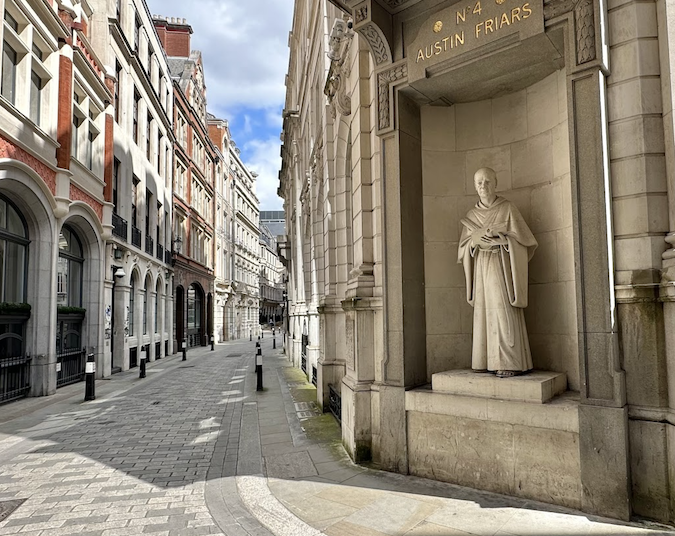If you walk from Throgmorton Street to Old Broad Street then left along London Wall before turning down Great Winchester Street to Drapers Gardens, you will pass the locations of many typical City of London activities: banks, asset managers and financial advisers, gyms, coffee shops, pubs and so forth. There are few clues to what was in the area long before, except within the streets called Austin Friars which hint at a remarkable past.
The name Austin Friars comes from a monastery established there by hermits from Tuscany, who arrived in England in 1249. They followed the rules of St Augustine. The word Austin is a contraction of Augustine. Founded in 1260s, the friary the street’s name also indicates lasted nearly 300 years until Henry VII’s Dissolution of the Monasteries.
The Dissolution, which began in 1536, can only be described as a revolutionary event, not just because a nation had to change its religion almost overnight, but also because the whole economy of London was hit by seismic change, as church and monastic property – which accounted for an astonishing 60 per cent of land in the City – suddenly came on to the market. It was snapped up by aristocrats, Henry’s cronies and other men on the make. Sir Simon Thurley, the architectural historian, observes: “The whole topography of the City of London was transformed in a period of less than five years.”
It is less well known that the man who spearheaded this revolution for Henry actually lived in Austin Friars, literally on monastic land. For all we know, his ghost may be lurking there. Thomas Cromwell took up residence in the early 1520s, well before the Reformation was conceived. By fair means and foul he expanded his holding to make it into his principal residence and a grand mansion worthy of the King’s chief of staff. We have a record of Cromwell’s ruthlessness. John Stow, author of the groundbreaking Survey of London, recorded for posterity how Cromwell seized land from his father, without compensation, in order to expand his garden.
It was from those premises that Cromwell plotted the Dissolution, helped, would you believe, by George Brown, the Abbot of Austin Friars, whom Cromwell enlisted in 1534 as a commissioner reporting on the state of the houses of the mendicant Roman Catholic orders.

If you wander around the land of the former monastery today – especially at weekends, when it is spookily quiet – you can’t avoid treading on Cromwell’s land and stumbling across buried memories. The frontage of his mansion, with its three turrets giving the impression of a mini-castle, is the lower of the two buildings highlighted in red on the Agas map above. Although the map doesn’t show this, it actually stretched along Throgmorton Street, which is not shown on the map but is situated between Lothbur (Lothbury) and Brode (Old Broad Street).
The mansion had over 50 rooms and three courtyards. Nick Holder, an archaeological historian who has done extensive research on Austin Friars, says Cromwell ended up with one of the largest pre-Dissolution private properties in London, owning 2⅓ acres of land including what Stow described as a 1¼-acre “greater garden” and a quarter-acre “lesser gardeyn”.

The higher of the two building in red is the site of the old Priory church which became the Dutch church (above) when it was granted to German and Dutch religious exiles in 1550. It survived the Great Fire of 1666 only to be destroyed in the Second World War and subsequently rebuilt. The original church was famous for its spire, the shape of which is more obvious in the yellow insert on the Agas map, taken from a drawing by the Flemish artists Anton van den Wyngaerde. The Reverend Thomas Hugo, writing in 1859, described it as “one of the architectural marvels of London” and Stow said he had never seen the like.

The present church is worth a visit in order to savour its grand stained glass window and tapestries. Several stones from the original have been preserved under glass beside the altar (photo above) to maintain a link with the past. Perkin Warbeck, a pretender to the throne of England, is buried somewhere underneath.
Beyond the church there are railings through which you can see what was almost certainly part of Cromwell’s garden. Much of it was purchased by the Drapers livery company in 1544, soon after Henry’s death, along with Cromwell’s house. Despite being called Drapers Gardens, it has been the site of large office blocks since the 1960s. Yet it is still a living reminder of a turbulent past.
This is the 20th and final article in a series by Vic Keegan about locations of historical interest in the Eastern City part of the City of London kindly supported by EC BID, which serves that area. All the previous articles are here. On London’s policy on “supported content” can be read here.

